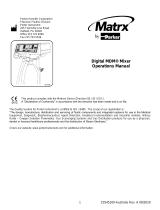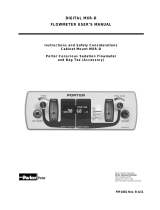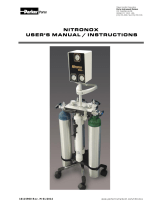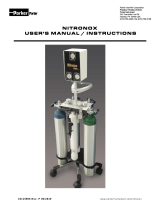Page is loading ...

MINISCAV™
Vacuum Pump Manual
North American Model
Caution: Federal law restricts this device to sale by or on the order of a physician or dentist.
MR Unsafe - Do not place or use Miniscav™ in or near an MRI enviroment


Figure 1 – MINISCAV™ and Accessories
Accessories:
1) External Wall Vent Assembly
2) USA Power Lead
3) Internal Transfer Hose Assembly
(supplied in 1 metre lengths)
Note: Longer hose lengths can be supplied - to be specied at
time of order
Indications for use:
The MINISCAV™ wae gas evacuation apparatus is intended to remove patients’ exhaled wae gases during
procedures where analgesia is adminiered to a patient via inspiration of mixtures of nitrous oxide and oxygen
from a nitrous oxide / oxygen delivery device. Not intended for use with ammable anehetic gases.
This device is intended for professional use only in healthcare facilities, clinics, and physician and denti oces.
Cautions:
• The MINISCAV™ is intended for connection to the vacuum outlet of a nitrous oxide/ oxygen
delivery device and to direct the waste gases to the outside via the transfer hose.
• Do not place the Miniscav™ close to the patient; typical distance is not closer than 1.5 meters.
Ensure sufficient space around the MINISCAV™ to ensure adequate cooling of the device do not
mount the MINISCAV™ in an enclosed area. Do not cover the MINISCAV™ with anything.
• Make sure that all connections are secure and that any tubing is in good shape, not kinked or
twisted. If you suspect any tubing is compromised, replace immediately.
• Remember to check before each use for correct installation.
• Only connect the MINISCAV to the “VAC” inlet nozzle of the N2O/O2 delivery equipment.
• Do not use with a Porter Automatic Vacuum Switch. This also applies to any other device where
vacuum is shut of by means of valving.
1
Installation Guidance:
1) On receipt of Miniscav™, unbox and check contents.
Note: It may be advisable to retain packaging for future service requirements.
2) Venting:
a) Install external rigid venting assembly in an outside wall, positioning as low as possible. Consideration
must be taken to place the vent at the furthest possible point from any potential ingress i.e. window or
doors. Recommended,, minimum 3 metres.
Ensure that the white elbow with stainless steel filter is placed externally.
b) Internal venting; When considering the course of pipework, avoid undue restrictions i.e. excessive use
of sharp bends or no more than a maximum rise of 6 metres. Maximum length of internal venting should
not exceed 15 metres or 50 feet.
3) Once the internal and external venting has been installed, position the Miniscav™ in operating position
and connect the hose to the grey snap-in inlet at the rear of the unit. The patient breathing circuit can
then be placed on the inlet nozzle barb connection.
4) Switch the Miniscav to 'on' position before entraining and oxygen/nitrous oxide flows.

• Connect the MINISCAV™ to a properly grounded hospital grade electrical outlet that meets
the power requirements as listed in the specifications section of this Manual.
• The Exhaust conduit from the outlet of the MINISCAV™ to the wall outlet should not be more
than 15 m (50 feet) in length.
Symbols:
“O” and “1” on the front panel green power switch mean Off and On respectively
Cleaning:
Disconnect the power cord from the MINISCAV™. Clean the outer surface of the MINISCAV™
with a soft cloth moistened with mild soap and water. Do not allow moisture to enter the unit.
It is not necessary to clean the accessory hoses as they are downstream of the patient although
the clear transfer hose can be cold sterilised if required.
Maintenance and Service:
• Replace the 19 mm transfer hose if there are any suspicions of wear, holes or tears.
• With the exception of fuses, the MINISCAV is not user serviceable. Return the MINISCAV to
vendor when service is required. Fuses should be replaced by qualified personnel with the
fuse ratings as listed on the rating plate on the rear of the device.
• To disconnect the unit, the front panel power switch should be turned off and the electric
power plug can be removed from its receptacle.
• There are no user serviceable parts. If service is needed contact your dealer.
• The MINISCAV incorporates a thermal cutoff safety mechanism that turns off the motor if
it gets too hot (lack of air flow, shut in a box etc.). If the front panel-light is on, but the pump is
not operating, the thermal cutout may have activated. To reset the thermal cutout unplug the
device for 30 minutes and try again. If the device still does not function return for service.
2
Figure 2 shows a simulated installation and venting to an outside wall.
Inlet Connecter Barb
Exhaust Connector
Power Cable
Exhaust Outlet
Angle down
To Breathing System
Side view
WALL

How to check Normal Operation?
• When running the MINISCAV™ on/off green switch will be illuminated
• One should hear a low humming sound which is the vacuum motor running
• There may be a slight whistle from the ambient air port on the equipment room-air valve.
• This means that make-up air volume is being entrained to help supply the fixed vacuum flow.
• If one does not hear or feel any suction at the end of the vacuum hose connected to the
MINISCAV™ input nozzle, check the MINISCAV™ and ensure that it is running and that the
hoses are not obstructed or kinked.
Compatibility
Equipment
The MINISCAV is intended for use with standard N2O/O2 flowmeter delivery systems and has been
tested with Porter, Accutron, and Nitronox equipment, specifically; Porter C3000 MXR, Digital MDM,
Analogue MDM, Nitronox, Accutron Ultra & Digital Ultra
The MINISCAV provides a Flow Rate of 42 Lpm +/- 5 Lpm at a fixed vacuum of <= 90 mmHg, which the
ADA has determined to be appropriate for the scavenging of nitrous oxide in mild sedation cases with
these types of delivery systems.
Scavenging and Patient Circuits
The patient circuit or the equipment must have a scavenging block and / or a room-air valve venting to the
room for any excessive positive or negative pressures.
http://www.ada.org/en/member-center/oral-health-topics/nitrous-oxide
Patient circuits styles include:
• Double nasal mask
• Full Face mask circuit
Pre-Use Check:
Check that ensure all hose connections are intact and secure and that tubing is not kinked
prior to use.
• After turning on the MINISCAV™ check to see that there is a positive vacuum flow at the
equipment inlet connection i.e. transfer hose and vent to atmosphere.
• Ensure that there is no kinking in the hoses
• Ensure that during operation that there is no gas leakage to the room. Check that all
connectors and connections are fully secure and intact.
3

Warnings:
• To avoid the risk of electric shock, the MINISCAV™ must only be connected to a grounded
electrical supply circuit.
• The MINISCAV™ should be placed outside the reach of patients, generally considered more
than 1.5 meters.
• Ensure sufficient space around the MINISCAV™ to ensure adequate cooling of the device, do
not mount the MINISCAV™ in an enclosed area.
• Do not cover the MINISCAV™ with anything.
• Make sure that all connecting hoses are secure and not kinked or obstructed
• With the exception of fuses, the MINISCAV™ is not user serviceable. Return the MINISCAV™
to the vendor if service is required.
• Do not use the MINISCAV™ in the presence of flammable anesthetics
• Make sure the device is used in consideration of the electromagnetic compatibility
environment described below.
• Only use the device in environmental descriptions as described below.
• This device and accessories should only be cleaned, disinfected or sterilized with mild
surface disinfectant products.
• The MINISCAV™ is not for use in an oxygen rich environment; defined as the ambient
oxygen concentration being higher than 25%
• Do not attempt to modify or alter the MINISCAV™
• Ensure that the exhaust hose is firmly connected. A louder noise will be heard if it becomes
disconnected.
• MR Unsafe – do not place MINISCAV in an MRI environment
Environmental Conditions:
Operating conditions
Operating temperature 5 to 40°C (41 to 104°F)
Relative humidity 5 to 95% (non-condensing)
Altitude -382 to 3011 m (-1253 to 9878 ft)
Transport and storage conditions
Temperature -40 to 70°C (-40 to 158°F)
Storage life 2 years
Relative Humidity 5 to 95% (non-condensing)
Altitude -382 to 5,572m (-1253 to 18280 ft)
Fuse Ratings: 5x20mm, 250V, 2A, T
4

Electromagnetic Compatibility
The information contained in this section (such as separation distances) is in general specifically
written with regard to the MINISCAV™. The numbers provided will not guarantee faultless
operation but should provide reasonable assurance of such. This information may not
be applicable to other medical electrical equipment; older equipment may be particularly
susceptible to interference.
General Notes:
Medical electrical equipment requires special precautions regarding electromagnetic compatibility
(EMC) and needs to be installed and put into service according to the EMC information provided
in this document and the remainder of the instructions for use this device.
Portable and mobile RF communications equipment can affect medical electrical equipment.
Cables and accessories not specified within the instructions for use are not authorized.
Using other cables and/or accessories may adversely impact safety, performance and
electromagnetic compatibility (increased emission and decreased immunity).
Care should be taken if the equipment is used adjacent to or stacked with other
equipment; if adjacent or stacked use is inevitable, the equipment should be observed to verify
normal operation in the configuration in which it will be used.
The device operated normally throughout all of the immunity tests.
Accessories
• Power Cord
• External wall vent assembly
• Exterior right angle elbow with mesh screen
• Interior right angle elbow with connector to transfer hose
• 2 ft. of 1⁄2 ID x 5/8” OD exhaust tube
User Supplied Accessory
Transfer hose – 19 mm ID x up to a maximum length of 15 meters (50 ft.) length. Note: requires
compatible quick connect fittings.
• Specifications for Gas Scavenging tubing
• 19 mm ID end-fittings
• Maximum Length - 15 metres +/- 10 cm (50 ft.)
• Sources for this hose – Anesthesia Associates, Inc. www.ainca.com (or suitable equivalent)
• Tubing should be inspected routinely and replaced when necessary
• Vacuum tubing - 10.5 mm ID (0.5 inch ID) standard vacuum tubing
5

Electromagnetic Immunity
This MINISCAV™ is intended for use in the electromagnetic environment specified below. The
user of this equipment should assure that is used in such an environment.
Immunity
against
IEC 60601-1-2 test level Compliance
level (of this
device)
Electromagnetic environment
electrostatic
discharge, ESD
(IEC 61000-4-2)
contact discharge: 6 kV
air discharge: 8 kV
6 kV
8 kV
Floors should be wood, concrete or
ceramic tile. If floors are covered
with synthetic material, the relative
humidity should be kept at levels
to reduce electrostatic charge to
suitable levels.
electrical fast
transients / bursts
(IEC 61000-4-4)
power supply lines: 2 kV
longer input /
output lines: 1 kV
2 kV
1 kV
Mains power quality should be that
of a typical commercial or hospital
environment.
surges on AC mains
lines
(IEC 61000-4-5)
Common mode: 2 kV
differential mode: 1 kV
2 kV
1 kV
Mains power quality should be that
of a typical commercial or hospital
environment.
power frequency
magnetic field 50/60
Hz
(IEC 61000-4-8)
3 A/m 3 A/m Equipment which emits high levels
of power line magnetic fields (in
excess of 3A/m) should be kept at
a distance to reduce the likelihood
of interference..
voltage dips and short
interruptions on AC
mains input lines
(IEC 61000-4-11)
dip >95%, 0.5 periods
dip 60%, 5 periods
dip 30%, 25 periods
dip >95%, 5 seconds
>95%, 0.5 per.
60%, 5 per.
30%, 25 per.
>95%, 5 sec.
Mains power should be that of
a typical commercial or hospital
environment. If user requires
continued operation during
power mains interruptions insure
that batteries are installed and
charged. Insure that battery life
exceeds longest anticipated power
outages or provide and additional
uninterruptible power source..
Electromagnetic Emissions
This MINSICAV™ is intended for use in the electromagnetic environment specified below. The
user of this equipment should assure that is used in such an environment.
Emissions Compliance according
to
Electromagnetic environment
RF emissions (CISPR 11) Group 1 The MINISCAV™ uses RF energy only for its
internal function. Therefore, its RF emissions
are very low and are not likely to cause any
interference in nearby electronic equipment.*
CISPR Emissions
Classification
Class B The MINISCAV™ is suitable for use in
all establishments including domestic
establishments and those directly connected
to the public low-voltage power supply network
that supplies buildings used for domestic
purposes.
Harmonic emissions
(IEC 61000-3-2)
Class A
Voltage fluctuations / flicker
(IEC 61000-3-3)
Complies
6

This MINISCAV™ is intended for use in the electromagnetic environment
specified below. The customer or the user of should assure that it is used in
such an environment.
Immunity test IEC 60601 test
level
Compliance
level
Electromagnetic environment – guidance
Conducted RF
rf coupled into
lines
(IEC 61000-4-6)
Radiated rf
(IEC 61000-4-3)
150 kHz to 80
MHz
outside ISM
bandsa
3 V/m
80 MHz – 2.5 GHz
3 Vrms
3 V/m
Portable and mobile RF communications
equipment should be used no closer to any part
of the, including cables, than the
recommended separation distance calculated
from the equation applicable to the frequency of
the transmitter as below.
Recommended separation distance
d=1.2P
d=1.2/P 80 MHz to 800 MHz
d=2.3P 800 MHz to 2.5 GHz
where P is the maximum output power rating
of the transmitter in watts (W) according to
the transmitter manufacturer and d is the
recommended separation distance in metres
(m).
Field strengths from fixed RF transmitters, as
determined by an electromagnetic site surveya,
should be less than the compliance level in
each frequency rangeb.
Interference may occur in the vicinity of
equipment marked with the following symbol:
a The ISM (industrial, scientific and medical) bands between 150 kHz and 80 MHz are 6,765 MHz to
6,795 MHz; 13,553 MHz to 13,567 MHz; 26,957 MHz to 27,283 MHz; and 40,66 MHz to 40,70 MHz.
a Field strengths from fixed transmitters, such as base stations for radio (cellular/cordless) telephones
and land
mobile radios, amateur radio, AM and FM radio broadcast and TV broadcast cannot be predicted
theoretically
with accuracy. To assess the electromagnetic environment due to fixed RF transmitters, an
electromagnetic site
survey should be considered. If the measured field strength in the location in which the equipment is
used exceeds the applicable RF compliance level above, the equipment should be observed to verify
normal operation. If abnormal performance is observed, additional measures may be necessary, such as
reorienting or relocating the equipment.
7

Recommended separation distances between portable and mobile RF
communications equipment and the MINISCAV™
Rated maximum output
power of transmitter W
Separation distance according to frequency of transmitters in meters
150 kHz – 80 MHz
d=1.2/V1]P
80 MHz to 800MHz
d=1.2/V1]P
800 MHz to 2.5 GHz
d=2.3P
0.01 0.12 0.12 0.23
0.1 0.38 0.38 0.73
11.2 1.2 2.3
10 3.8 3.8 7.3
100 12 12 23
For transmitters rated at a maximum output power not listed above, the recommended separation
distance d in meters (m) can be estimated using the equation applicable to the frequency of the
transmitter, where P is the maximum output power rating of the transmitter in watts (W) according to the
transmitter manufacturer.
NOTE 1 At 80 MHz and 800 MHz, the separation distance for the higher frequency range applies.
NOTE 2 These guidelines may not apply in all situations. Electromagnetic propagation is affected by
absorption and
reflection from structures, objects and people.
Specifications:
Vacuum Pump: Diaphragm type, fixed flow rate and fixed vacuum
Flow rate 42 Lpm +/- 5 Lpm
Vacuum Fixed – maximum 90 mmHg +/- 10 mmHg
Power Requirements: 115 VAC +/-10% 60 Hz 2.0 A
Protection Class: Class 1 (Protectively Earthed)
Size: Width 160mm, Length 370mm, Height 260mm
Maximum length 15 metres (50 ft.) in length
Outlet tubing
Ingress Protection: The device is not protected against ingress of water or particulate matter
Weight: 9.25 kg
Mode of Operation: Continuous
8


Manufactured by:
R A MEDICAL SERVICES LTD
Holmes House, Skipton Road, Steeton
West Yorkshire BD20 6SD U.K.
Email: [email protected]
Exclusively Distributed by:
SEDATION SYSTEMS LLC
2471 McMullen Booth Road, Suite 316
Clearwater, Florida 33759 USA
Contact: S Michael Bender
Toll Free: 888.959.5288
Email: [email protected]
NAB/REV04
June 2017
/










